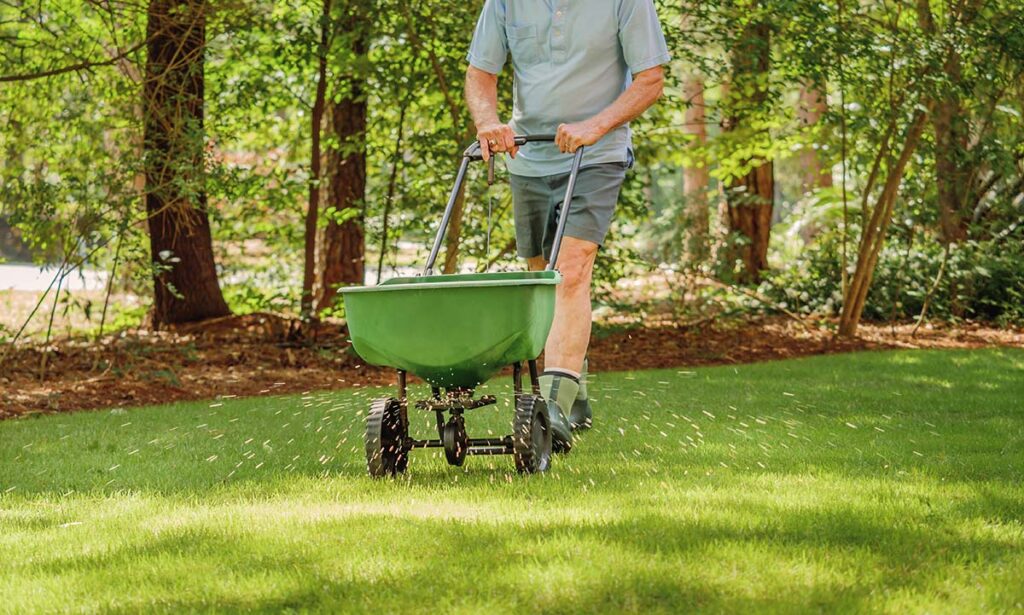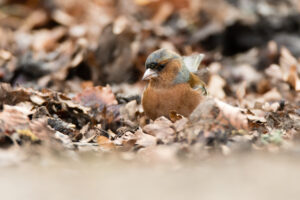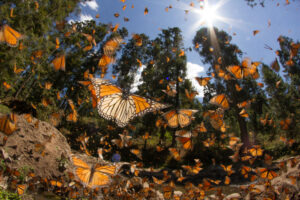Written by: Tom Andrews

Spring Fertilizing
You’ve already learned about general fertilizing from our “The What, When, & Why of Fertilizing” blog, but what should you do when spring comes around?
One of the first things I do in the spring is walk the yard. I look for trouble areas like disease, bare spots, pick-up sticks, etc. This will help in your program planning for the year. After the yard walk, I grab the rake and do a light raking of the entire yard. Raking lifts the blades smashed from the winter snow and dormancy and increases airflow and sunlight to the whole plant. I like to do one somewhat aggressive mow to start the year, cutting off the brown tips of the blades. Again, not breaking the 1/3rd rule.
Now that the lawn is clean, it’s time for a pre-emergent and fertilizer. For my spring pre-emergent product, I like a product whose primary active ingredient is “prodiamine.” Using pre-emergent helps prevent many weeds, including crabgrass. Alongside that application, I start the year with a low-rate fertilizer, known as a “starter fertilizer.”
You will usually see on the bag numbers such as 10-10-10 or similar on starter fertilizers. Those numbers stand for nitrogen, phosphorus, and potassium, or as some call it: “up, down, and around.” Nitrogen promotes upward growth. Generally speaking, phosphorus encourages root growth while potassium promotes lateral growth.
I usually do a starter fertilizer on my first 1-2 applications of the year, allowing the grass to wake up slowly. Once the green-up has begun, you can increase the nutrient rates. For example, you can use a fertilizer like a 16-4-8, then even move up to a 24-0-11. You want to remember to ease into it.
To get that extra punch of green, you need to look at that iron content on the fertilizer bag to show that domination line. Most bags have rates around 0.5 – 2.0%. Some fertilizers are designed explicitly for that punch of green by including “iron” or “green” in their name. To help for that quick green-up, you’ll want a “fast release” fertilizer with 1 – 5% iron content. Some have much higher iron contents (excess of 10 – 20+ %). While they may sound great, I would use caution and refer to that soil test you took earlier in the year. There is such thing as too much iron.
One added product I like to recommend in the spring is a grub/pest product. While I am a big advocate for pollinators, controlling some of these pests like grubs (Japanese Beetle larvae) will help your lawn and garden in the long run. There are organic options on the market for these, and I’ve had great success with them. So, if you see grubs in your yard feeding on your lawn’s roots and you do not treat them, they will later become beetles and feed on your garden flowers.
Mowing in the spring can be fun. You can learn to master designs with a nice stripe kit on your mower and highlight that domination line with your next-door neighbor, with their lawn full of dandelions. I recommend that a higher cut for cool season lawns is better.
You can find your recommended height for your grass type by reaching out to your extension office as well. One important recommendation is that you do not want to mow right after fertilizing. It is best to mow right before, but if you must (or forgot to) mow before, you do not want to bag your clippings. Bagging your grass clippings right after fertilizing will risk some of the fertilizer being picked up in the mower.




